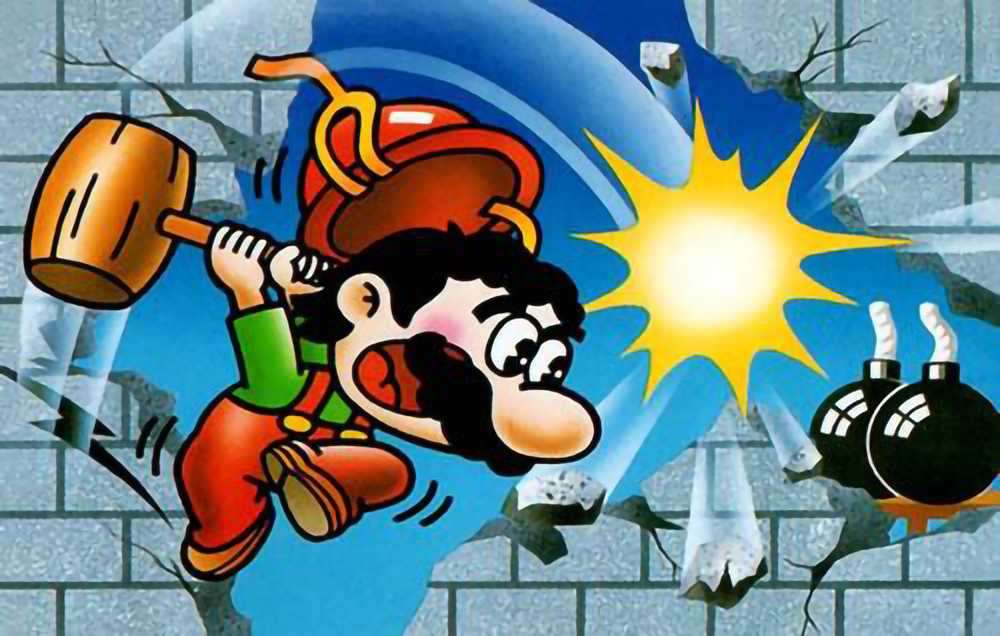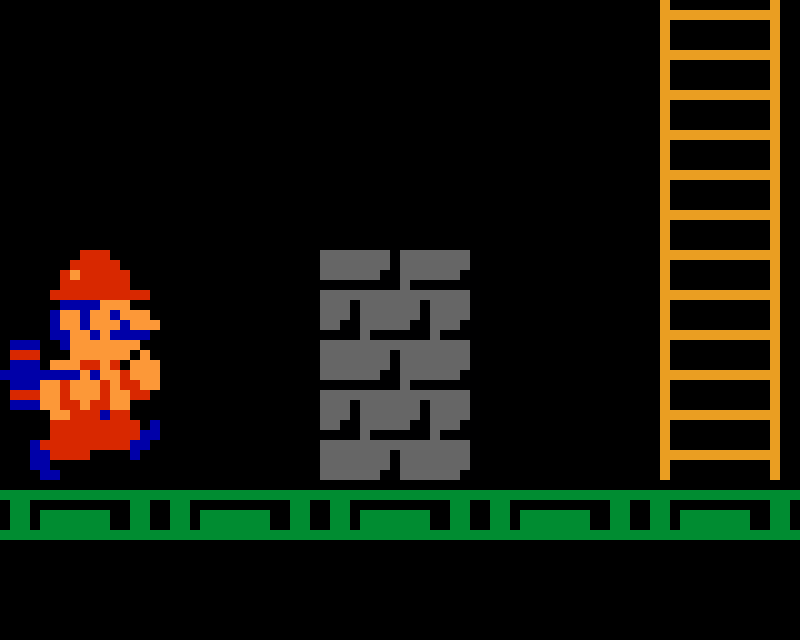Mario's Bizarre Side-Gig
Does Nintendo’s iconic plumber mention his Wrecking Crew stint on his CV?

The original Mario Bros. marked a major change in the life and career of Mario. Prior to this game’s release, Mario was a carpenter (and, apparently, an abusive pet-owner if Donkey Kong has anything to say about it). Mario Bros., first released as an arcade game in 1983, was a radical departure. Not only had Mario given up his one-time role as chief antagonist, but he also undertook something of a lateral promotion. Rather than spending his time dodging barrels in pursuit of his kidnapped girlfriend, Mario — with brother Luigi in tow — was doing something far more constructive: ridding the New York City sewer system of all manner of nasty critters.
For designers Shigeru Miyamoto and Gunpei Yokoi, this represented an enormous contextual shift. Mario did retain his signature jumping ability, but significant changes were made. For one thing, in Donkey Kong, Mario would be “stunned” if he fell any distance greater than his own height. It was actually Yokoi who suggested that, in Mario Bros., it should be possible to fall from any height without consequence. Where Donkey Kong featured various obstacles that Mario had to avoid (like rolling barrels), Mario Bros. contained enemies (the aforementioned critters) that Mario and Luigi had to defeat. Again, it was Yokoi who suggested that — given the levels contained numerous floors — it might be a good idea for the player to hit the enemy from underneath. This would flip them over, leaving them in a (temporary) helpless state for the player to race over and deliver the decisive blow. Miyamoto and Yokoi struggled to think of what kind of creature would naturally fit this scenario. In the end, though, turtles made the most sense (knocking them from underneath would flip them on their back, where they would be helpless for a limited period of time).
In the early ’80s, Miyamoto’s star was rising within Nintendo. And although he had invented the Mario character, he wasn’t yet solely responsible for all aspects of Mario game design as mentioned in the above Mario Bros. example. Throughout the ’80s, Mario made appearances in games made by other veteran designers at Nintendo. This includes one very strange-yet-delightful secondment courtesy of one Yoshio Sakamoto (director of several Metroid titles, and a designer on numerous other Nintendo games).
Wrecking Crew, released on the Famicom in 1985, is a captivating little game both from a Mario fan’s point of view but also as a standalone experience. From my perspective, it feels like some kind of missing link; I had never played the original NES version. My first experience with Wrecking Crew was via the Nintendo Switch Online service.
So what is Wrecking Crew, then?

In some respects, it’s not too dissimilar from Mario Bros; there’s no horizontal scrolling and you’re primarily moving up and down rather than left and right. Levels here do scroll vertically, though, which provides for larger and more detailed environments. Like Mario Bros., there are enemies that will take you out with a single hit — but that’s largely where the similarities end. Wrecking Crew is the far more complex, ambitious design.
For one thing, your goal here isn’t to destroy all the enemies. Instead, you’ll run around the level wielding a large hammer, which is used to destroy various objects placed around the environment. As a professional wrecker, your goal is simple: destroy all the objects, including everything from walls to ladders. Objects often take several whacks with the hammer before they’re reduced to rubble. Sounds simple, right? Well, there are a few twists here. The most important of which is that you can’t simply undertake your work unimpeded. Like Mario Bros., you’ll encounter enemies roaming around the environment and it’ll be necessary to avoid them entirely if you want to beat the level. There’s also a kind of boss character called Spike, who is apparently the construction site foreman, who will chase you around and attempt to disrupt you in various ways (including by dropping objects on you from overhead). What an HR nightmare.
Making matters worse is the fact that Mario can’t jump, owing to the weighty hammer he needs for wrecking purposes.

So what you end up with is a pretty compelling hybrid platform-puzzler. As you work your way through levels (there are 100 of them in total, which I find kind of mind-blowing), you’ll need to exercise two important skills at once: your platforming reaction time needs to be sharp to avoid enemies, but it’s also necessary to plot out the ideal wrecking route as quickly as possible. You won’t have very long to look at the level before you’re thrown into the action. This is important, because right up front, it’s necessary to think through the order in which you’ll tackle all of the destructible objects — it’s very possible to find yourself cornered by Spike, or to accidentally destroy an object you’ll actually need later to reach a certain area (for instance, you might take out a ladder too early, leaving you unable to reach a destructible wall above).
I was pleasantly surprised to discover just how much I’m enjoying Wrecking Crew on the Nintendo Switch. It’s still exciting, challenging, and hilarious despite being some thirty-five years old. If you’re interested in checking out the game yourself, you can easily access it via Nintendo Switch Online if you have a subscription. You can also nab Vs. Wrecking Crew, a home console port of the mid-80s arcade game that is also available on Switch as part of the Arcade Archives games on the Nintendo eShop.
